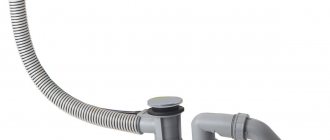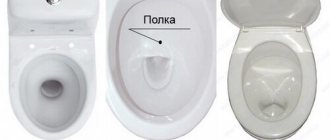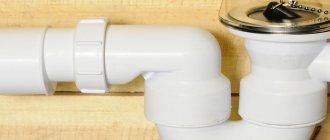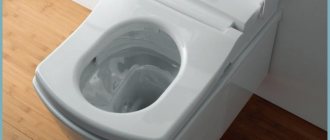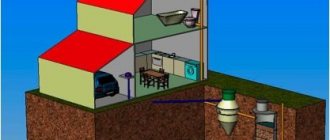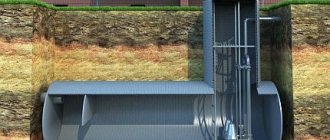Are you faced with the fact that you don’t know how to install a drain in the bathroom? In the minds of many people, only a professional plumber with a large number of tools can perform such work. However, not everything is as complicated as it might seem. After reading the material presented, you will understand that installing a drain can be done with your own hands.
Siphons can be of different heights. Therefore, the first thing you need to do is measure the distance from the bottom of the bath to the floor. It must be at least 15 cm. If the bathtub has not yet been installed, then you need to install it and secure it firmly - it should not move.
What is this device
Bath siphon
How to install a drain in a bathroom? For a person who is not familiar with this kind of terminology, such a question can only raise additional questions; in fact, this means that a special siphon with an outlet for connecting the overflow will be installed in the bathroom. This is exactly what we will talk about, but first you need to understand the structure and operating principle of this device.
Siphon operating principle
Water seal diagram
Regardless of the design, the drain is equipped with a siphon, in which there must always be water, and if it evaporates or the water seal fails, then unpleasant odors from the sewer pipe will enter the room. To prevent this from happening, a drain pipe or vacuum valve must be installed.
If the reason for installing a new drain is that it smells bad, then you need to determine whether the siphon is to blame.
Design characteristics of semi-automatic
The semi-automatic bath fitting has a rather complex design, which is characterized by an additional shut-off valve controlled by a lever on the overflow hole. It can be made in the form of a button, a decorative valve, or a rotary ring. Control occurs using a system of cables and other additional connecting parts. The advantages of such a siphon lie primarily in convenience and comfort of use. The closed overflow device has a high aesthetic appeal.
On the other hand, the complexity of the design and the presence of many moving parts reduce the reliability of such systems.
When purchasing siphons of this type, it is important to pay special attention to manufacturers of high-quality fittings for sanitary equipment that have proven themselves well. The durability and uninterrupted operation of these drains directly depends on this.
Bath drain device
Simple bath siphon
Having decided to purchase the simplest modern bathtub drain, you will be faced with the fact that instead of the device shown in the picture, you will be given a bag with a bunch of plastic parts. Don't be afraid! If not you, then your children or grandchildren assembled Lego. You can be sure that assembling the siphon is much easier and faster.
How to assemble
Drain device
So, the siphon was purchased and delivered home. To ensure that no part is lost, you need to open the package and lay out the contents on a wide table, or better yet, on the floor. Carefully inspect every detail to ensure there is no flaw. Check whether the threaded parts connect freely.
Branded siphons are packaged in a cardboard box and come with detailed assembly instructions. Defective parts are almost never found.
It is unlikely that you will be able to find thorough assembly instructions there - at best, a small drawing of a siphon. Since there are not as many parts as it might seem, it will not be difficult to find its place for each. What is worth paying close attention to is which side to install the rubber seals. The fact is that they are cone-shaped. There is one rule for installing these rubber bands - the narrow part is towards the neck, and the wide part is towards the nut, which is clearly visible in the figure (shown by brown arrows). You should not immediately crimp all connections, as local adjustments may be required.
Drain installation
Siphon installation
After assembling the drain, you need to install it in the bathtub.
- First of all, you need to check if there are any pieces of the old gasket or any adhering debris left. The landing area must be clean and smooth (both inside and outside the bath). If this is not the case, then installation cannot be performed until the problem is resolved.
- The lower part of the siphon has a wide neck with a lower part from the inside - this is a seat for the gasket (shown by the blue arrow). If the length of the arms allows, then further installation can be performed without an assistant. The siphon with the gasket placed on it is brought under the lower hole of the bathtub and held in this position.
- From inside the bathtub, check that the bottom gasket has not moved to the side.
- A gasket is placed on the drain hole (the green arrow points to it), the top cover with the grill is installed and screwed on. In modern models, fixation is carried out with a copper screw; in older models, the lid is threaded and screwed directly into the siphon.
Clamp the siphon
- In the same way, the overflow hole is tied and connected to the siphon using a flexible hose with pre-installed nuts and cone washers.
- The next step is to connect to the sewer. As a rule, there are no problems when connecting to PVC sewer pipes, but in order to connect to a cast iron pipe, you will have to purchase a rubber coupling of the appropriate size.
- Having crimped all connections, you need to check if there are any leaks. This is done simply - water is drawn into the bathtub, and you need to look under the bathtub. Then you need to close the plug and check if drops of water appear from below when the bath fills up a little. The final step will be to check the tightness of the overflow installation. To do this, you need to draw water until it flows into the siphon through the overflow.
Is it dry under the bathtub? Then the installation of the siphon is completed successfully.
Plastic parts are not very durable, so you don’t need to put much effort into fixing them. If you find a leak, disassemble the connection and, lubricating the gasket with plumbing silicone, reassemble.
Automatic types of drains
Now let's look at what an automatic drain and overflow is and how to install it correctly.
It is important to take into account that among these devices there are models in which the drain is controlled differently.
- Automatic drain and overflow.
- Semi-automatic drain and overflow.
It would be wrong to say that one is easy to use and the other is not, since they are structurally different. Therefore, everyone chooses the drainage mechanism at their own discretion.
If we talk about cheap models, then the automatic overflow will not last long. Since it cannot be repaired, the entire device will soon have to be replaced again.
Installation of a semi-automatic siphon
Alkaplast bathroom overflow drain
Semi-automatic siphons (like automatic ones) can be made from:
- sanitary plastic;
- brass;
- copper;
- chrome steel;
- silumin.
Silumin siphon is the worst choice. Not only can it break during installation, but after a while it can simply fall apart. Products made of copper, brass and chrome-plated steel can be called durable, but due to their high cost they are not in great demand.
Parts and assembly order
Products made from sanitary plastic are stronger than silumin siphons and more durable, since they are not afraid of aggressive environments. A significant role in the popularity of plastic products is played by their low cost and ease of installation. As for the assembly, the process is not much more complicated than installing an ordinary plastic drain and overflow, and differs only in that instead of grilles you need to install controls, as shown in the diagram above.
Material selection
Regardless of the type of siphons, they can be made from a variety of materials:
- brass;
- steel;
- different types of plastic.
Recently, plastic siphons have become the most popular. This material is not subject to corrosion and rotting, it does not rust and is resistant to water of any hardness. It is recommended to choose PVC pipes with increased hardness.
Practical advice
Siphon installation
The purchased drainage system must be convenient and reliable, which must be taken care of in advance. When making a choice, it is important to pay attention to the following:
- The drain mechanism can be controlled by a valve, button or handle. Decide in advance and firmly decide which mechanism will suit you and be most convenient. If it’s hard to imagine, then you can go to a plumbing store and ask the seller to show different models.
- If you purchase a metal drain-overflow system, you definitely need to find out what metal it is made of. Some manufacturers of silumin products spray them and in appearance they are very similar to brass products.
- A white bathtub will harmonize with any colors of siphon lids. The main thing is that there is no clutter and disharmony with the style of the room.
- Automatic or semi-automatic? Don’t rush to make a decision just after hearing the word machine. The method of draining is fundamentally different. In an automatic system, in order to activate the drain mechanism, you need to apply force to the lid covering the drain hole. If you need to drain the water while taking a bath, then there is no problem. The semi-automatic system controls the drainage system from the outside.
- When choosing a semi-automatic system, it is important to pay attention to the location of the control cable - it can be either outside or inside the overflow pipe. The last option for the cable arrangement is more aesthetic, but cannot be repaired.
Installing a siphon on a bathtub yourself is not difficult. You must follow the advice from the instructions provided for assembling and installing a specific equipment model.
Which pipes to choose for sewerage
| Pipe type | Peculiarities |
| bays | There are no sockets, so connections are made with couplings. But there are no scraps or waste left. |
| In pieces | A piece of pipe is inserted into the socket of the previous one; fittings are used only when it is necessary to change the direction of drains, when combining horizontal lines, etc. |
Horizontal lines are mounted from 50 mm pipes, risers - from 100 mm.
For stable operation of the system after each bath, sink, washing machine, etc. (except for the toilet and shower) you need to install a gyroscope siphon. Siphons are installed by default in toilets and showers.
On curved sections, standard fittings without threads are used. It is recommended to install assemblies from pipe fittings rather than using ready-made ones.


